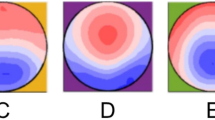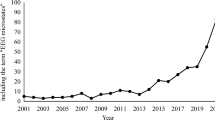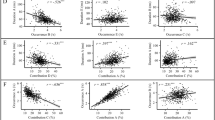Abstract
Dynamic changes in ERP topographies can be conveniently analyzed by means of microstates, the so-called “atoms of thoughts”, that represent brief periods of quasi-stable synchronized network activation. Comparing temporal microstate features such as on- and offset or duration between groups and conditions therefore allows a precise assessment of the timing of cognitive processes. So far, this has been achieved by assigning the individual time-varying ERP maps to spatially defined microstate templates obtained from clustering the grand mean data into predetermined numbers of topographies (microstate prototypes). Features obtained from these individual assignments were then statistically compared. This has the problem that the individual noise dilutes the match between individual topographies and templates leading to lower statistical power. We therefore propose a randomization-based procedure that works without assigning grand-mean microstate prototypes to individual data. In addition, we propose a new criterion to select the optimal number of microstate prototypes based on cross-validation across subjects. After a formal introduction, the method is applied to a sample data set of an N400 experiment and to simulated data with varying signal-to-noise ratios, and the results are compared to existing methods. In a first comparison with previously employed statistical procedures, the new method showed an increased robustness to noise, and a higher sensitivity for more subtle effects of microstate timing. We conclude that the proposed method is well-suited for the assessment of timing differences in cognitive processes. The increased statistical power allows identifying more subtle effects, which is particularly important in small and scarce patient populations.







Similar content being viewed by others
References
Arzy S, Mohr C, Michel CM, Blanke O (2007) Duration and not strength of activation in temporo-parietal cortex positively correlates with schizotypy. Neuroimage 1:326–333. doi:10.1016/j.neuroimage.2006.11.027
Brandeis D, Naylor H, Halliday R, Callaway E, Yano L (1992) Scopolamine effects on visual information processing, attention, and event-related potential map latencies. Psychophysiology 3:315–336
Brandeis D, Lehmann D, Michel CM, Mingrone W (1995) Mapping event-related brain potential microstates to sentence endings. Brain Topogr 2:145–159
Brunet D, Murray MM, Michel CM (2011) Spatiotemporal analysis of multichannel EEG: CARTOOL. Comput Intell Neurosci. doi:10.1155/2011/813870
Chouiter L, Dieguez S, Annoni JM, Spierer L (2013) High and low stimulus-driven conflict engage segregated brain networks, not quantitatively different resources. Brain Topogr. doi:10.1007/s10548-013-0303-0
Darque A, Del ZM, Khateb A, Pegna AJ (2012) Attentional modulation of early ERP components in response to faces: evidence from the attentional blink paradigm. Brain Topogr 2:167–181. doi:10.1007/s10548-011-0199-5
De Lucia M, Michel CM, Murray MM (2010) Comparing ICA-based and single-trial topographic ERP analyses. Brain Topogr 2:119–127. doi:10.1007/s10548-010-0145-y
De Lucia M, Tzovara A, Bernasconi F, Spierer L, Murray MM (2012) Auditory perceptual decision-making based on semantic categorization of environmental sounds. Neuroimage 3:1704–1715. doi:10.1016/j.neuroimage.2012.01.131
Devijver PA, Kittler J (1982) Pattern recognition: a statistical approach. Prentice-Hall, London
Grieder M, Crinelli RM, Koenig T, Wahlund LO, Dierks T, Wirth M (2012) Electrophysiological and behavioral correlates of stable automatic semantic retrieval in aging. Neuropsychologia 50(1):160–171. doi:10.1016/j.neuropsychologia.2011.11.014
Kikuchi M, Koenig T, Wada Y, Higashima M, Koshino Y, Strik W, Dierks T (2007) Native EEG and treatment effects in neuroleptic-naïve schizophrenic patients: time and frequency domain approaches. Schizophr Res 97(1-3):163–172. doi:10.1016/j.schres.2007.07.012
Knebel JF, Murray MM (2012) Towards a resolution of conflicting models of illusory contour processing in humans. Neuroimage 3:2808–2817. doi:10.1016/j.neuroimage.2011.09.031
Koenig T, Melie-Garcia L (2010) A method to determine the presence of averaged event-related fields using randomization tests. Brain Topogr 3:233–242. doi:10.1007/s10548-010-0142-1
Koenig T, Lehmann D, Merlo MC, Kochi K, Hell D, Koukkou M (1999) A deviant EEG brain microstate in acute, neuroleptic-naive schizophrenics at rest. Eur Arch Psychiatry Clin Neurosci 4:205–211
Koenig T, Prichep L, Lehmann D, Sosa PV, Braeker E, Kleinlogel H, Isenhart R, John ER (2002) Millisecond by millisecond, year by year: normative EEG microstates and developmental stages. Neuroimage 1:41–48. doi:10.1006/nimg.2002.1070
Koenig T, Melie-Garcia L, Stein M, Strik W, Lehmann C (2008) Establishing correlations of scalp field maps with other experimental variables using covariance analysis and resampling methods. Clin Neurophysiol 6:1262–1270. doi:10.1016/j.clinph.2007.12.023
Koenig T, Kottlow M, Stein M, Melie-Garcia L (2011) Ragu: a free tool for the analysis of EEG and MEG event-related scalp field data using global randomization statistics. Comput Intell Neurosci. doi:10.1155/2011/938925
Kottlow M, Praeg E, Luethy C, Jancke L (2011) Artists’ advance: decreased upper alpha power while drawing in artists compared with non-artists. Brain Topogr 4:392–402. doi:10.1007/s10548-010-0163-9
Kovalenko LY, Chaumon M, Busch NA (2012) A pool of pairs of related objects (POPORO) for investigating visual semantic integration: behavioral and electrophysiological validation. Brain Topogr 3:272–284. doi:10.1007/s10548-011-0216-8
Kutas M, Hillyard SA (1980) Reading senseless sentences: brain potentials reflect semantic incongruity. Science 207:203–205
Laganaro M, Perret C (2011) Comparing electrophysiological correlates of word production in immediate and delayed naming through the analysis of word age of acquisition effects. Brain Topogr 1:19–29. doi:10.1007/s10548-010-0162-x
Lehmann D (1990) Brain electric microstates and cognition: the atoms of thought. In: John ER Vol. Machinery of the mind. Birkhäuser, Boston, pp 209–224
Lehmann D (1987) Principles of spatial analysis. In: Gevins A, Remond A (eds) Methods of analysis of brain electrical and magnetic signals: handbook of electroencephalography and clinical neurophysiology, vol 1. Elsevier, Amsterdam, pp 309–354
Lehmann D, Skrandies W (1980) Reference-free identification of components of checkerboard-evoked multichannel potential fields. Electroencephalogr Clin Neurophysiol 6:609–621
Lehmann D, Skrandies W (1984) Spatial analysis of evoked potentials in man—a review. Prog Neurobiol 3:227–250
Lehmann D, Wackermann J, Michel CM, Koenig T (1993) Space-oriented EEG segmentation reveals changes in brain electric field maps under the influence of a nootropic drug. Psychiatry Res 4:275–282
Lehmann D, Faber PL, Galderisi S, Herrmann WM, Kinoshita T, Koukkou M, Mucci A, Pascual-Marqui RD, Saito N, Wackermann J, Winterer G, Koenig T (2005) EEG microstate duration and syntax in acute, medication-naive, first-episode schizophrenia: a multi-center study. Psychiatry Res 2:141–156. doi:10.1016/j.pscychresns.2004.05.007
Manly BFJ (2007) Randomization. Bootstrap and Monte Carlo Methods in Biology. Chapman & Hall, Boca Raton
McCarthy G, Wood CC (1985) Scalp distributions of event-related potentials: an ambiguity associated with analysis of variance models. Electroencephalogr Clin Neurophysiol 3:203–208
Megevand P, Quairiaux C, Lascano AM, Kiss JZ, Michel C (2008) A mouse model for studying large-scale neuronal networks using EEG mapping techniques. Neuroimage 42(2):591–602. doi:10.1016/j.neuroimage.2008.05.016
Michel C, Koenig T, Brandeis D (2009) Electrical neuroimaging in the time domain. In: Michel CM, Koenig T, Brandeis D, Gianotti LRR and Wackermann J, Vol. Electrical Neuroimaging, Cambridge, pp 111–143
Murray MM, Brunet D, Michel CM (2008) Topographic ERP analyses: a step-by-step tutorial review. Brain Topogr 4:249–264. doi:10.1007/s10548-008-0054-5
Nishida K, Morishima Y, Yoshimura M, Isotani T, Irisawa S, Jann K, Dierks T, Strik W, Kinoshita T, Koenig T (2013) EEG microstates associated with salience and frontoparietal networks in frontotemporal dementia, schizophrenia and Alzheimer’s disease. Clin Neurophysiol 6:1106–1114. doi:10.1016/j.clinph.2013.01.005
Overney LS, Michel CM, Harris IM, Pegna AJ (2005) Cerebral processes in mental transformations of body parts: recognition prior to rotation. Brain Res Cogn Brain Res 3:722–734. doi:10.1016/j.cogbrainres.2005.09.024
Pannekamp A, van der Meer E, Toepel U (2011) Context- and prosody-driven ERP markers for dialog focus perception in children. Brain Topogr 3–4:229–242. doi:10.1007/s10548-011-0194-x
Pascual-Marqui RD, Michel CM, Lehmann D (1995) Segmentation of brain electrical activity into microstates: model estimation and validation. IEEE Tran Biomed Eng 7:658–665. doi:10.1109/10.391164
Pegna AJ, Khateb A, Spinelli L, Seeck M, Landis T, Michel CM (1997) Unraveling the cerebral dynamics of mental imagery. Hum Brain Mapp 5(6):410–421. doi:10.1002/(SICI)1097-0193(1997)5:6<410:AID-HBM2>3.0.CO;2-6
Perret C, Laganaro M (2012) Comparison of electrophysiological correlates of writing and speaking: a topographic ERP analysis. Brain Topogr 1:64–72. doi:10.1007/s10548-011-0200-3
Pourtois G (2011) Early error detection predicted by reduced pre-response control process: an ERP topographic mapping study. Brain Topogr 4:403–422. doi:10.1007/s10548-010-0159-5
Pourtois G, Delplanque S, Michel C, Vuilleumier P (2008) Beyond conventional event-related brain potential (ERP): exploring the time-course of visual emotion processing using topographic and principal component analyses. Brain Topogr 20(4):265–277. doi:10.1007/s10548-008-0053-6
Spierer L, Tardif E, Sperdin H, Murray MM, Clarke S (2007) Learning-induced plasticity in auditory spatial representations revealed by electrical neuroimaging. J Neurosci 20:5474–5483. doi:10.1523/JNEUROSCI.0764-07.2007
Stein M, Dierks T, Brandeis D, Wirth M, Strik W, Koenig T (2006) Plasticity in the adult language system: a longitudinal electrophysiological study on second language learning. Neuroimage 33(2):774–783. doi:10.1016/j.neuroimage.2006.07.008
Stevenson RA, Bushmakin M, Kim S, Wallace MT, Puce A, James TW (2012) Inverse effectiveness and multisensory interactions in visual event-related potentials with audiovisual speech. Brain Topogr 3:308–326. doi:10.1007/s10548-012-0220-7
Strik W, Fallgatter AJ, Brandeis D, Pascual-Marqui RD (1998) Three-dimensional tomography of event-related potentials during response inhibition: evidence for phasic frontal lobe activation. Electroencephalogr Clin Neurophysiol 4:406–413
Taha H, Ibrahim R, Khateb A (2013) How does arabic orthographic connectivity modulate brain activity during visual word recognition: an ERP study. Brain Topogr 2:292–302. doi:10.1007/s10548-012-0241-2
Tzovara A, Murray MM, Michel C, De Lucia M (2012a) A tutorial review of electrical neuroimaging from group-average to single-trial event-related potentials. Dev Neuropsychol 6:518–544. doi:10.1080/87565641.2011.636851
Tzovara A, Murray MM, Plomp G, Herzog MH, Michel CM, De Lucia M (2012b) Decoding stimulus-related information from single-trial EEG responses based on voltage topographies. Pattern Recogn 6:2109–2122
Tzovara A, Rossetti AO, Spierer L, Grivel J, Murray MM, Oddo M, De Lucia M (2013) Progression of auditory discrimination based on neural decoding predicts awakening from coma. Brain 1:81–89. doi:10.1093/brain/aws264
Wackermann J, Lehmann D, Michel CM, Strik WK (1993) Adaptive segmentation of spontaneous EEG map series into spatially defined microstates. Int J Psychophysiol 3:269–283
Author information
Authors and Affiliations
Corresponding author
Rights and permissions
About this article
Cite this article
Koenig, T., Stein, M., Grieder, M. et al. A Tutorial on Data-Driven Methods for Statistically Assessing ERP Topographies. Brain Topogr 27, 72–83 (2014). https://doi.org/10.1007/s10548-013-0310-1
Received:
Accepted:
Published:
Issue Date:
DOI: https://doi.org/10.1007/s10548-013-0310-1




